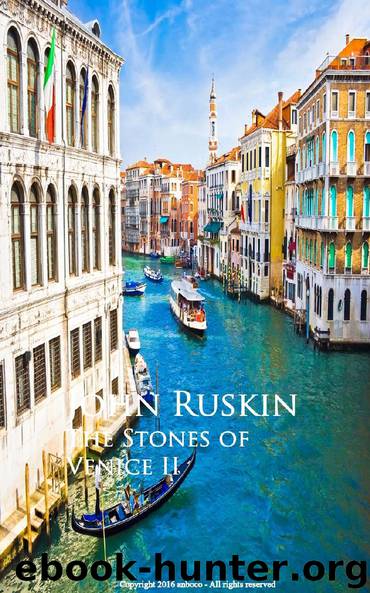The Stones of Venice II by John Ruskin

Author:John Ruskin [Ruskin, John]
Language: eng
Format: epub
Published: 2016-07-31T00:00:00+00:00
§ LXXIII. The fifth element above named was Rigidity ; and this character I must endeavor carefully to define, for neither the word I have used, nor any other that I can think of, will express it accurately. For I mean, not merely stable, but active rigidity; the peculiar energy which gives tension to movement, and stiffness to resistance, which makes the fiercest lightning forked rather than curved, and the stoutest oak-branch angular rather than bending, and is as much seen in the quivering of the lance as in the glittering of the icicle.
§ LXXIV. I have before had occasion (Vol. I. Chap. XIII. § VII. ) to note some manifestations of this energy or fixedness; but it must be still more attentively considered here, as it shows itself throughout the whole structure and decoration of Gothic work. Egyptian and Greek buildings stand, for the most part, by their own weight and mass, one stone passively incumbent on another: but in the Gothic vaults and traceries there is a stiffness analogous to that of the bones of a limb, or fibres of a tree; an elastic tension and communication of force from part to part, and also a studious expression of this throughout every visible line of the building. And, in like manner, the Greek and Egyptian ornament is either mere surface engraving, as if the face of the wall had been stamped with a seal, or its lines are flowing, lithe, and luxuriant; in either case, there is no expression of energy in framework of the ornament itself. But the Gothic ornament stands out in prickly independence, and frosty fortitude, jutting into crockets, and freezing into pinnacles; here starting up into a monster, there germinating into a blossom; anon knitting itself into a branch, alternately thorny, bossy, and bristly, or writhed into every form of nervous entanglement; but, even when most graceful, never for an instant languid, always quickset; erring, if at all, ever on the side of brusquerie.
§ LXXV. The feelings or habits in the workman which give rise to this character in the work, are more complicated and various than those indicated by any other sculptural expression hitherto named. There is, first, the habit of hard and rapid working; the industry of the tribes of the North, quickened by the coldness of the climate, and giving a n expression of sharp energy to all they do (as above noted, Vol. I. Chap. XIII. § VII.), as opposed to the languor of the Southern tribes, however much of fire there may be in the heart of that languor, for lava itself may flow languidly. There is also the habit of finding enjoyment in the signs of cold, which is never found, I believe, in the inhabitants of countries south of the Alps. Cold is to them an unredeemed evil, to be suffered, and forgotten as soon as may be; but the long winter of the North forces the Goth (I mean the Englishman, Frenchman, Dane, or German), if
Download
This site does not store any files on its server. We only index and link to content provided by other sites. Please contact the content providers to delete copyright contents if any and email us, we'll remove relevant links or contents immediately.
| African | Asian |
| Australian & Oceanian | Canadian |
| Caribbean & Latin American | European |
| Jewish | Middle Eastern |
| Russian | United States |
4 3 2 1: A Novel by Paul Auster(11071)
The handmaid's tale by Margaret Atwood(6867)
Giovanni's Room by James Baldwin(5889)
Big Magic: Creative Living Beyond Fear by Elizabeth Gilbert(4730)
Asking the Right Questions: A Guide to Critical Thinking by M. Neil Browne & Stuart M. Keeley(4591)
On Writing A Memoir of the Craft by Stephen King(4220)
Ego Is the Enemy by Ryan Holiday(3999)
Ken Follett - World without end by Ken Follett(3980)
The Body: A Guide for Occupants by Bill Bryson(3813)
Bluets by Maggie Nelson(3721)
Adulting by Kelly Williams Brown(3678)
Guilty Pleasures by Laurell K Hamilton(3597)
Eat That Frog! by Brian Tracy(3522)
White Noise - A Novel by Don DeLillo(3439)
The Poetry of Pablo Neruda by Pablo Neruda(3370)
Alive: The Story of the Andes Survivors by Piers Paul Read(3318)
The Bookshop by Penelope Fitzgerald(3234)
The Book of Joy by Dalai Lama(3231)
Fingerprints of the Gods by Graham Hancock(3218)
